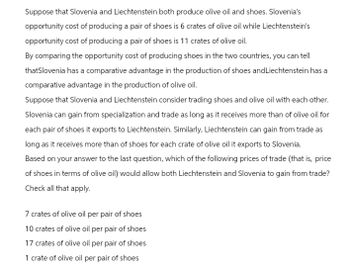
Principles of Economics 2e
2nd Edition
ISBN: 9781947172364
Author: Steven A. Greenlaw; David Shapiro
Publisher: OpenStax
expand_more
expand_more
format_list_bulleted
Question
Don't use Ai

Transcribed Image Text:Suppose that Slovenia and Liechtenstein both produce olive oil and shoes. Slovenia's
opportunity cost of producing a pair of shoes is 6 crates of olive oil while Liechtenstein's
opportunity cost of producing a pair of shoes is 11 crates of olive oil.
By comparing the opportunity cost of producing shoes in the two countries, you can tell
thatSlovenia has a comparative advantage in the production of shoes and Liechtenstein has a
comparative advantage in the production of olive oil.
Suppose that Slovenia and Liechtenstein consider trading shoes and olive oil with each other.
Slovenia can gain from specialization and trade as long as it receives more than of olive oil for
each pair of shoes it exports to Liechtenstein. Similarly, Liechtenstein can gain from trade as
long as it receives more than of shoes for each crate of olive oil it exports to Slovenia.
Based on your answer to the last question, which of the following prices of trade (that is, price
of shoes in terms of olive oil) would allow both Liechtenstein and Slovenia to gain from trade?
Check all that apply.
7 crates of olive oil per pair of shoes
10 crates of olive oil per pair of shoes
17 crates of olive oil per pair of shoes
1 crate of olive oil per pair of shoes
Expert Solution
This question has been solved!
Explore an expertly crafted, step-by-step solution for a thorough understanding of key concepts.
Step by stepSolved in 2 steps

Knowledge Booster
Similar questions
- In Germany it takes three workers to make one television and four workers to make one video camera. In Poland It takes six workers to make one television and 12 workers to make one video camera. Who has the absolute advantage in the production of televisions? Who has the absolute advantage in the production of video cameras? How can you tell? Calculate the opportunity cost of producing one additional television set in Germany and In Poland. (Your calculation may involve fractions, which Is tine.) Which country has a comparative advantage in the production of televisions? Calculate the opportunity cost of producing one video camera in Germany and in Poland. Which country has a comparative advantage in the production of video cameras? In this example, is absolute advantage the same as comparative advantage, or not? In what product should Germany specialize? In what product should Poland specialize?arrow_forwardBrazil can produce 100 pounds of beef or 10 autos. In contrast the United States can produce 40 pounds of beef or 30 autos. Which country has the absolute advantage in beef? Which country has the absolute advantage in producing autos? What is the opportunity cost of producing one pound of beef In Brazil? What is the opportunity cost of producing one pound of beef in the United States?arrow_forwardTrue or False: The source of comparative advantage must be natural elements like climate and mineral deposits. Explain.arrow_forward
- Assume two countries, Thailand (T) and Japan (J), have one good: cameras. The demand (d) and supply (s) for cameras In Thailand and Japan is described by the following functions: QsT=-5+14P QsJ=-10+14P QdT=60-P QdJ=80-P P is the price measured in a common currency used in both countries, such as the Thai Baht. Compute the equilibrium price (P) and quantities in each country without trade. Now assume that free trade occurs. The free-trade price goes to 56.36 Baht. Who exports and Imports cameras and in what quantities?arrow_forwardWhy might intra-industry trade seem surprising from the point of view of comparative advantage?arrow_forwardHow does comparative advantage lead to gains from trade?arrow_forward
arrow_back_ios
arrow_forward_ios
Recommended textbooks for you
 Principles of Economics 2eEconomicsISBN:9781947172364Author:Steven A. Greenlaw; David ShapiroPublisher:OpenStax
Principles of Economics 2eEconomicsISBN:9781947172364Author:Steven A. Greenlaw; David ShapiroPublisher:OpenStax
 Microeconomics: Private and Public Choice (MindTa...EconomicsISBN:9781305506893Author:James D. Gwartney, Richard L. Stroup, Russell S. Sobel, David A. MacphersonPublisher:Cengage Learning
Microeconomics: Private and Public Choice (MindTa...EconomicsISBN:9781305506893Author:James D. Gwartney, Richard L. Stroup, Russell S. Sobel, David A. MacphersonPublisher:Cengage Learning Macroeconomics: Private and Public Choice (MindTa...EconomicsISBN:9781305506756Author:James D. Gwartney, Richard L. Stroup, Russell S. Sobel, David A. MacphersonPublisher:Cengage Learning
Macroeconomics: Private and Public Choice (MindTa...EconomicsISBN:9781305506756Author:James D. Gwartney, Richard L. Stroup, Russell S. Sobel, David A. MacphersonPublisher:Cengage Learning Economics: Private and Public Choice (MindTap Cou...EconomicsISBN:9781305506725Author:James D. Gwartney, Richard L. Stroup, Russell S. Sobel, David A. MacphersonPublisher:Cengage Learning
Economics: Private and Public Choice (MindTap Cou...EconomicsISBN:9781305506725Author:James D. Gwartney, Richard L. Stroup, Russell S. Sobel, David A. MacphersonPublisher:Cengage Learning Exploring EconomicsEconomicsISBN:9781544336329Author:Robert L. SextonPublisher:SAGE Publications, Inc
Exploring EconomicsEconomicsISBN:9781544336329Author:Robert L. SextonPublisher:SAGE Publications, Inc

Principles of Economics 2e
Economics
ISBN:9781947172364
Author:Steven A. Greenlaw; David Shapiro
Publisher:OpenStax


Microeconomics: Private and Public Choice (MindTa...
Economics
ISBN:9781305506893
Author:James D. Gwartney, Richard L. Stroup, Russell S. Sobel, David A. Macpherson
Publisher:Cengage Learning

Macroeconomics: Private and Public Choice (MindTa...
Economics
ISBN:9781305506756
Author:James D. Gwartney, Richard L. Stroup, Russell S. Sobel, David A. Macpherson
Publisher:Cengage Learning

Economics: Private and Public Choice (MindTap Cou...
Economics
ISBN:9781305506725
Author:James D. Gwartney, Richard L. Stroup, Russell S. Sobel, David A. Macpherson
Publisher:Cengage Learning

Exploring Economics
Economics
ISBN:9781544336329
Author:Robert L. Sexton
Publisher:SAGE Publications, Inc